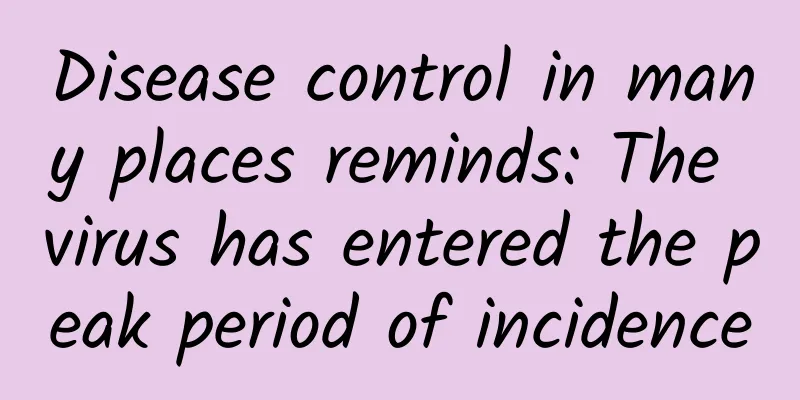Disease control in many places reminds: The virus has entered the peak period of incidence

|
Recently, disease control departments in many places have reminded: Acute infectious diarrhea caused by Norovirus has entered the peak period of incidence! What is Norovirus? Norovirus, formerly known as Norwalk virus, belongs to the Caliciviridae family. The virus has the characteristics of short incubation period, rapid mutation, strong environmental resistance, diverse transmission routes, and low infection dose, so it is easy to spread among people and is the most important pathogen causing acute gastroenteritis. Everyone is generally susceptible to the virus. The immune protection produced by human infection with norovirus is short-lived, so the same person can be repeatedly infected with the same strain or different types of norovirus. How is norovirus spread? Norovirus is a highly contagious virus. The feces and vomit of patients with norovirus gastroenteritis contain a large amount of the virus, which can easily cause infection if not handled properly. It often causes collective outbreaks in schools, childcare institutions, nursing homes, and restaurants. Norovirus is mainly transmitted through the fecal-oral route, including ingestion of aerosols produced by patient feces or vomitus, or ingestion of food or water contaminated by feces or vomitus, as well as indirect contact with environmental object surfaces contaminated by feces or vomitus. What are the main symptoms of norovirus infection? The incubation period of norovirus infection is usually 24 to 48 hours, with the shortest being 12 hours and the longest being 72 hours. Norovirus gastroenteritis is generally mild, with vomiting and diarrhea being the most common symptoms, followed by nausea, abdominal pain, headache, fever, chills, and muscle aches. The symptoms of acute norovirus gastroenteritis in adults and children are different, with vomiting being the main symptom in children and diarrhea being the main symptom in adults. Norovirus gastroenteritis generally presents with an acute onset and is a self-limiting disease, with most patients recovering within 2 to 3 days of onset. However, for infants, young children, and the elderly, especially those with underlying diseases, norovirus gastroenteritis can lead to more serious symptoms such as dehydration. When is Norovirus infection most prevalent? Norovirus infection can occur throughout the year, with a higher incidence in cold seasons, usually from October to March of the following year. Because of its obvious seasonality, it is also called "winter vomiting disease." Every 2 to 3 years, a new variant of the norovirus may appear, causing a global epidemic. How should Norovirus gastroenteritis be treated? Patients with norovirus gastroenteritis do not need to take antibiotics, but should drink water to prevent dehydration. Taking oral rehydration salts (ORS) can help patients replenish water and balance electrolytes. If vomiting or diarrhea symptoms are severe, seek medical attention immediately. How to prevent norovirus infection? At present, there are norovirus-specific antiviral drugs and vaccines, and its prevention and control mainly adopt non-drug prevention measures. The antibodies produced after norovirus infection have no obvious protective effect, so repeated infection is very likely to occur. You should take these precautions at ordinary times: Maintaining good hand hygiene is the most important and effective measure to prevent norovirus infection and control the spread of norovirus. Wash your hands correctly according to the 6-step hand washing method before meals and after defecation, and wash with soap and running water for at least 20 seconds. It should be noted that disinfectant wipes and hand sanitizers cannot replace hand washing (according to standard procedures). If a family member is infected with norovirus, the sick family member should try not to have close contact with other healthy family members, especially not to cook or take care of the elderly and infants. Wash fruits and vegetables carefully, cook food correctly, especially shellfish and seafood, which are at high risk of infection with norovirus, and make sure they are thoroughly cooked. During the illness, patients with norovirus gastroenteritis are advised to stay at home and isolate themselves until 2 days after the symptoms completely disappear (because the patient still excretes a small amount of toxins after the symptoms completely disappear) to avoid infecting other people, especially those working in the service industry and collective institutions, such as chefs, caregivers, and school and kindergarten teachers. When a cluster or outbreak of norovirus gastroenteritis occurs, comprehensive disinfection should be carried out, focusing on the surfaces of environmental objects, daily necessities, food processing tools, drinking water, etc. contaminated by pollutants such as vomit and feces of patients. Chlorine-containing disinfectants are most commonly used. How to deal with the patient’s vomit and feces? It is worth noting that alcohol is ineffective against norovirus, and chlorine-containing disinfectants are most effective against norovirus. Use gauze, rags or other disposable absorbent materials to soak 5000mg/L (milligrams/liter) to 10000mg/L of chlorine-containing disinfectant to completely cover the pollutants and carefully clean them. The pollutants should be centrally disposed of as medical waste, or soaked in a disinfectant containing 5000mg/L of effective chlorine for 30 minutes before disposal. Pour enough water into the toilet bowl. 5000mg/L to 10000mg/L chlorine-containing disinfectant for more than 30 minutes. Tools such as rags and containers containing contaminants must be soaked in a disinfectant solution containing 5000 mg/L of effective chlorine for 30 minutes and then thoroughly rinsed before they can be used again. Mops used to clean toilets and bathrooms in collective units should be dedicated. When handling vomit and feces of sick children, be sure to take personal protection measures. Source: Beijing Youth Daily, China News Service, China CDC News, Beijing Daily |
Recommend
Is breast plastic surgery safe?
In recent years, breast plastic surgery has been ...
What are the side effects of ovarian cyst surgery?
Ovarian cysts are being taken seriously by more a...
What to do if your ovaries shrink
For female friends, ovarian atrophy is very dange...
What should women do if they have chronic urinary tract infection?
Chronic urinary tract infection in women is a ver...
Can pregnant women with high blood sugar eat potatoes?
Can pregnant women with high blood sugar eat pota...
The difference between the symptoms of miscarriage and menstruation
It should be said that women nowadays are more ca...
Pictures of boils on the vulva
Getting angry easily and causing boils on the vul...
What kind of woman is the most attractive?
Every woman hopes to be charming. This charm shou...
Can severe fallopian tube obstruction be cured?
In modern society, with the increase of various w...
What is the cause of heavy bleeding during medical abortion?
There are many people who suffer miscarriages in ...
Is it necessary to have a curettage if the uterus is not involution?
The importance of the uterus to women is obvious....
Girl lying flat ribs protruding
Important reminder: It is definitely abnormal if ...
Light blood after urinating
Adult women have their period every month, and va...
What is the situation when the lower body feels wet?
With the development of puberty, women's bodi...
What to do if you have a second ectopic pregnancy
Ectopic pregnancy is a serious disease, especiall...









